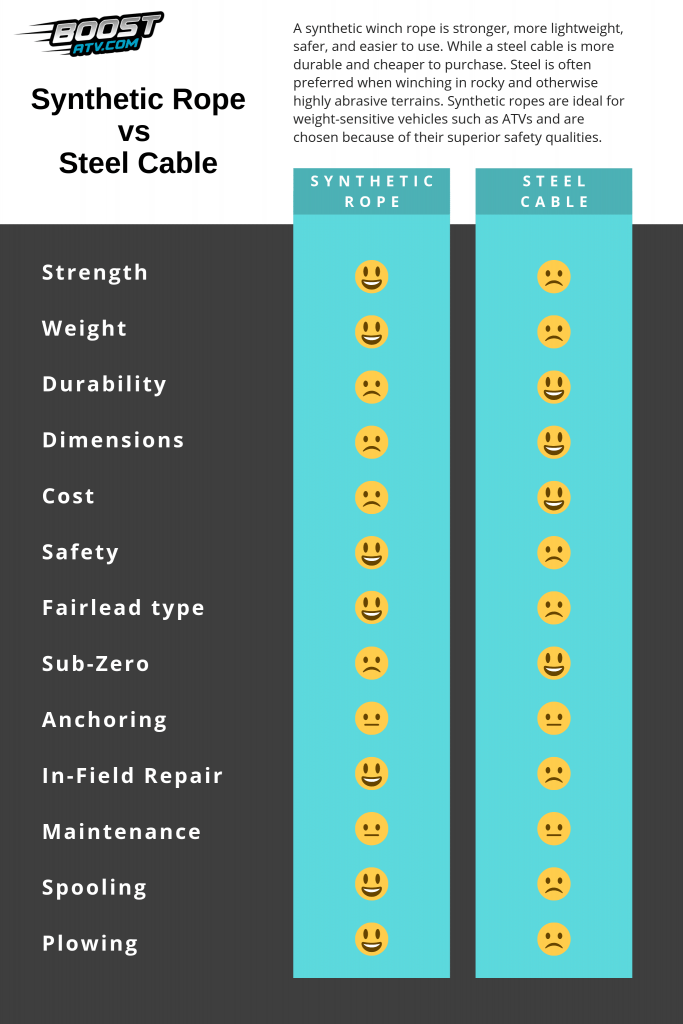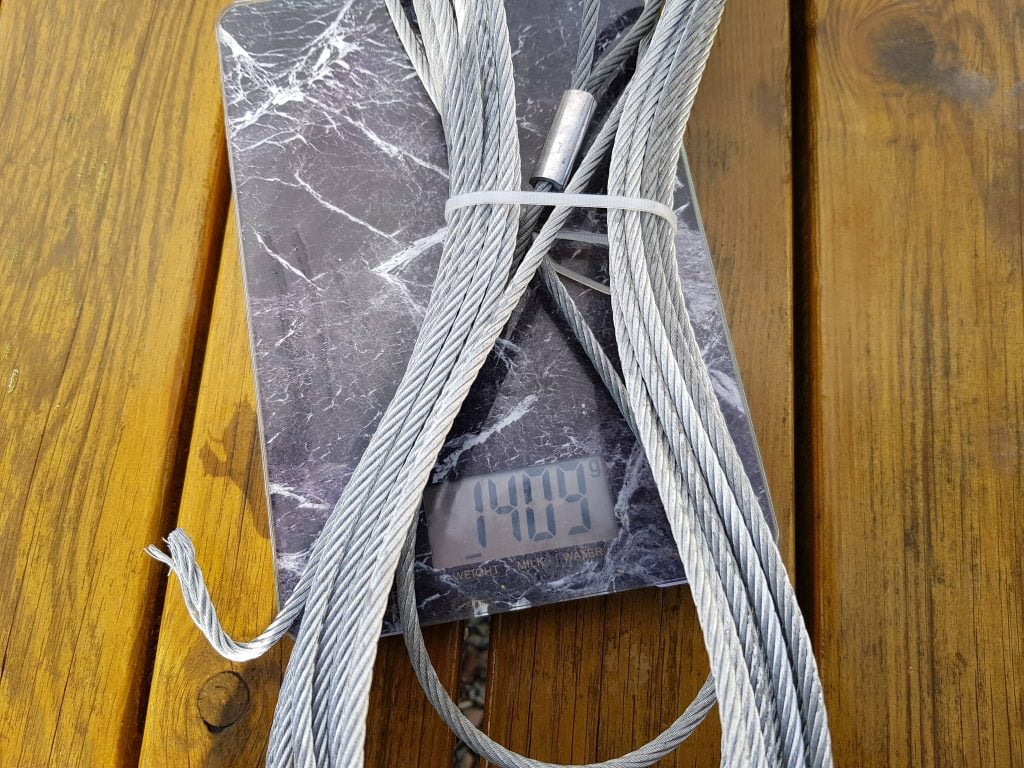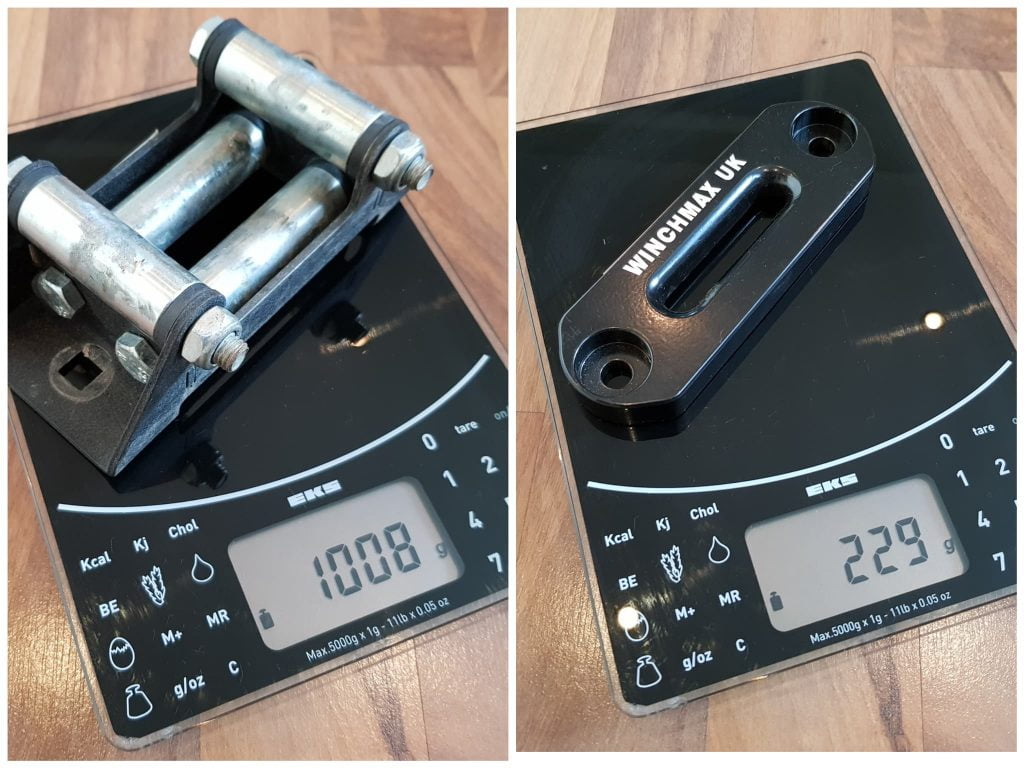This post will cover the pros and cons of synthetic winch ropes vs. steel winch cables for ATV and off-road use. Hopefully, it will make it easier for you to choose between the two.
Aircraft-grade steel cables have been the industry standard since the early days of ATV and off-road winching. Then, about 25 years ago, modern microfiber technology gave us synthetic winch ropes.
They are two great products with a fair share of upsides and downsides. And the fact that both products are still in the market today shows that both have their place.
There is no definite answer to which is better. However, one has a few upsides, making it a favorite amongst off-road enthusiasts worldwide.
Summary – Synthetic Winch Rope vs. Steel Cable
- A synthetic winch rope offers superior breaking strength and is lighter, safer, and more user-friendly.
- In comparison, a steel cable is more durable and cheaper to purchase.
- Steel is often preferred when winching in rocky and otherwise highly abrasive terrains.
- Synthetic ropes are ideal for weight-sensitive vehicles such as ATVs and are chosen because of their superior safety qualities.
| Criteria | Winner |
|---|---|
| Breaking Strength | Synthetic Rope |
| Weight | Synthetic Rope |
| Durability and Wear | Steel Cable |
| Dimensions | Steel Cable |
| Cost | Steel Cable |
| Safety | Synthetic Rope |
| Fairlead Design | Synthetic Rope |
| Sub-Zero Capabilities | Steel Cable |
| Anchoring | Draw |
| In-Field Repairs | Synthetic Roipe |
| Maintenance | Draw |
| Spooling | Synthetic Rope |
| Use for Plowing | Synthetic Rope |

To write this post, I examined a wide range of relevant parameters. I wanted to find out how well the two cable types hold up against each other within each criterion.
Breaking Strength
Synthetic winch ropes are crafted from polyethylene, with Dyneema being recognized as the premium brand.
Millions of tiny fibers combined into one super strong rope make the material well-suited for most off-road winching applications.
Steel cables are also made up of many fine threads. But instead of synthetic fibers, they use aircraft-grade metal strings braided together to make a solid but flexible metal cable.
If we compare the breaking strength of the same-size synthetic rope with steel cable, the rope comes out as the clear winner.
A synthetic winch rope is generally about 1.3 to 2 times stronger than the equivalent steel cable.
When compared by weight, a synthetic rope of similar weight is 15 times stronger than a steel cable.
I recommend that you get a genuine Dyneema product. If you get a cheap knockoff, you have no guarantee on what minimum break strength to expect from your rope.
Winner: Synthetic rope
Weight
Synthetic rope weighs about 1/6 of what similar steel cable weighs.
The front suspension on an ATV already has to withstand severe abuse from jumps, hard braking, and rough terrain. To make matters even worse, we install a heavy winch at the very front of the machine.
One way to improve your ride’s handling is to reduce the combined weight of the winch assembly.
Replacing a steel cable with a few oz lighter synthetic rope may not seem like it will make much of a difference. But if you also consider that a synthetic rope will allow you to replace your steel roller fairlead with one made from lightweight aluminum, the numbers start adding up.



Replacing both the steel cable and the steel roller fairleads with a synthetic rope and aluminum fairleads will bring the total weight of your winch down by as much as 20% – 30%.
Let us compare the weight of the most common ATV winch cable dimensions:
Material | Length | Thickness | Cable weight | Fairlead weight |
Synthetic | 50 ft (15m) | 3/16 in. (5mm) | 8.5oz (250g) | 36oz (1008g) |
Steel | 50 ft (15m) | 5/32 in. (4mm) | 50oz (1409g) | 8oz (229g) |
Winner: Synthetic rope
Durability and Wear
Synthetic ropes and steel cables experience wear and tear; they should be considered consumables.
But synthetic will generally wear faster than steel. This is one of the significant downsides of using a synthetic material. It is also why some users prefer traditional steel cables.
It’s not as much the actual winching that wears the rope synthetic, but it is prone to abrasion. The rope will wear prematurely whenever you winch in abrasive terrains with sharp rocks and sandy mud.
Steel cables are much more abrasive resistant. They can handle considerably more of this kind of abuse before you start seeing any noticeable wear, such as fraying and abrading.
Another downside with synthetic ropes is that the polyethylene material they are made of will degrade over time when exposed to UV radiation from the sun.
To prevent this, keep the cable out of the sun whenever possible. Use a protective cover if there is room for one.
The synthetic material may also degrade if it gets into contact with chemicals or high temperatures.
One or more of these exposures will likely happen during the rope’s lifespan. Any one of them has the potential to weaken the rope significantly. Genuine Dyneema can handle temperatures up to 150 °F (65°C) before it starts deteriorating.
Synthetic rope manufacturers do their best to compensate for these downsides.
Some will add a protective anti-abrasion nylon sleeve that slides the entire length of the rope. The idea is to use the sleeve as a protector whenever you need to winch over trunks, rocks, and other objects that may potentially damage the rope itself.

Most manufacturers also add various coatings to protect the rope from UV exposure and chemicals or to improve their durability in other ways.
The rope is most susceptible to heat exposure when it is close to the winch drum. Some winches have the winch brake located inside the actual winch drum. When the brake is applied, heat will build up from the friction.
Only the initial few feet of the rope come into direct contact with the potentially hot metal. Some manufacturers provide ropes equipped with a special heat guard to safeguard this section of the rope. This guard also serves as an effective shield against drum abrasion.
To give you an idea of how a synthetic winch rope will wear over time, I have included a photo of the cable on my own winch.
I‘ve been winching quite often over the last three years, and the rope is still in decent shape. I’ve used it to demolish a wooden dam, log by log, and countless self-rescue operations.
Once, I even pulled a massive Ford F250 pickup running summer tires out of a deep snowy ditch.

Winner: Steel cable
Dimensions
Winch wires for ATVs are typically 5/32 inches (4mm) in diameter, while the most common synthetic rope size is 3/16 inches (5mm).
Since the same size synthetic rope is stronger than the steel cable, you can step down one size and still maintain the same minimum breaking strength. This allows you to
However, synthetic ropes in diameters less than 3/16 inches (5mm) are not readily available on the market, so that’s the smallest diameter you can use.
Most available ATV winches have room for 50ft (15m) of rope or more but can fit even more steel cable.
Winner: Steel cable
Cost
Synthetic rope is typically about 2,5 times more expensive than wire cable, depending on which brand and what level of quality you choose.
After reading this post, you should be able to decide whether the extra cost is worth it.
For me, it’s an easy decision; a synthetic rope is worth every penny.
Most entry-level winches do, however, come stock with steel winch cables. Partly because steel has been the norm for many years and because steel cables generally cost less.
Winner: Steel cable
Safety
When winching with your ATV or off-road vehicle, there’s always an inherent risk.
It’s essential to minimize the likelihood of something unexpected happening. Still, at the same time, it’s just as crucial to reduce the potential consequences when things do not go as planned.
Because if you’re not careful, things can indeed go wrong. Neglecting to take the necessary precautions beforehand could potentially lead to fatal consequences.
Snapped Winch Cable
A winch cable or rope that snaps under high tension is one of the potentially most dangerous things that may happen when using the winch. Any winch rope or cable may break, regardless of what material they are made of.
But synthetic ropes are much safer when they do break.
When the winch starts pulling, what happens is that you store an increasing amount of potential energy in the rope or cable. If the rope or cable breaks under tension, this stored energy will turn the cable into a violent and potentially dangerous projectile.
The heavier steel cable will hold much more energy than the lighter synthetic rope when under the same tension. Visualize dropping a bowling ball vs. a ballon on your foot from the same height. The weight makes all of the difference.
Also, the elongation in a synthetic winch rope is minimal. This helps to reduce the amount of energy that builds up and makes the rope behave as safely as possible if it breaks.
The more elastic steel cable will come flying when it breaks, while the synthetic will drop to the ground more or less.
This is why using a line damper is essential, especially when using steel cables.
So, due to less weight and less elongation, a synthetic rope will not inflict anywhere near as much damage if it breaks as the heavy cable would. And therefore, it’s considered a much safer option.
Winner: Synthetic rope
Torn Hands
Another common winching injury, which most experienced winch owners will know all too well, is what happens if you grab a worn and burred winch cable barehanded.
Even after a few times of use, the cable will start forming small burs that can cause you a lot of pain. That’s why you should never handle a steel cable without proper gloves.
Synthetic winch cables, on the other hand, do not have this problem. Even worn and seasoned ropes can be handled safely and comfortably without gloves.
Winner: Synthetic rope
Aluminum Hawse vs. Steel Roller Fairlead
In principle, synthetic ropes can be used with both steel roller fairleads as well as a billet aluminum hawse. In comparison, the steel cable needs steel rollers as it will tear into the softer aluminum.
But using synthetic ropes with steel rollers is generally not recommended. Here is why:
- Some steel rollers are not designed to be used with synthetic ropes. The rope will flatten out when under tension. And because of the way many steel rollers are designed, you risk snagging issues in the corners where the rollers meet.
- Bolts and spindles on a steel roller may cause snagging issues as well. On a billet aluminum hawse, there is nothing the rope can catch onto.
- Any steel roller will eventually rust after some use, which is terrible news for the rope.
- The synthetic rope is very smooth. Because of this, the rollers will often not roll properly; the rope will slide against a roller that does not move.
- Finally, there’s the fact that a billet aluminum Hawse weighs much less than steel rollers.
If you still want to use a steel roller fairlead with a synthetic rope, you must ensure it has no previous damage from using a steel cable. Any burrs or scuffing in the rollers will wear the synthetic rope prematurely.
There are roller fairleads available in the market, specifically designed for use with synthetic ropes. These incorporate synthetic plastic materials in the rollers to prevent any damage to the rope.
I recommend replacing your steel roller fairlead with a lighter aluminum hawse when replacing your steel cable with a synthetic rope. They weigh less, cost less, and overall less can break.

Winner: Synthetic rope (with a billet aluminum hawse)
Sub-Zero Capabilities
Synthetic rope carries the disadvantage of retaining water, thereby adding weight to what would otherwise be a lightweight setup. Although the added weight isn’t necessarily a deal-breaker, combining this with sub-zero temperatures could lead to unfortunate outcomes.
If the water-soaked rope freezes, it may transform your winch into a useless block of ice. If you plan to ride in arctic conditions, ensure your synthetic rope stays relatively dry.
Steel cable does not hold water the same way and is less likely to freeze.
Winner: Steel cable
Anchoring
A common rookie mistake is to anchor the winch rope or cable by looping it around your anchor object and hooking it to itself.
This method is not suitable neither for winch ropes or steel cables and should be avoided for several reasons:
- The hook will damage the rope.
- The anchor may damage the rope (especially if it’s a rock).
- The rope may damage the anchor (especially if it’s a tree).
The correct way is to use a tree strap around the anchor. Use a shackle to connect the winch hook to the tree strap.
Here are 16 other cool ATV winch accessories.
At the hook end of the rope, it’s crucial to have a proper steel thimble in place. Both steel cables and synthetic ropes should feature one to ensure a safe and durable connection between the cable and the hook.
Winner: Draw
In-Field Repairs
Synthetic rope has the benefit that you can splice it if it breaks. In the worst case, you can tie a solid knot and proceed with your rescue operation.
If your steel cable breaks, there is no way you can repair the damage. If you don’t have any friends there to winch you out, you may have to rely on your own two feet to get back home.
Winner: Synthetic rope
Maintenance
A synthetic rope needs more maintenance and care than steel cable. You must wash it regularly in hot soapy water to keep it in good shape. Otherwise, grains of sand will work their way into the rope’s core, which will wear the rope every time you use it.
With steel cable, you can get away with spraying with wd 40 or chain lube from time to time to prevent it from rusting. If you do not take proper care of the cable, however, rust will start developing, soon losing some of its strength.
Winner: Draw
Spooling
Spooling the rope or cable correctly back onto the winch drum is an essential part of your winch maintenance routine. But this part is even more critical when it comes to steel cables.
If the relatively stiff steel cable doesn’t spool smoothly and evenly onto the drum, you risk getting permanent kinks in the cable, making spooling even harder next time.
Steel cables generally don’t take bending very well. Keeping a steel cable bent will deform and weaken the cable permanently.
Another benefit of synthetic ropes is that they can be stacked to one side of the drum without breaking the winch rods like a steel cable would.
Winner: Synthetic rope
Related: 6 Ways to Untangle a Stuck or Jammed-up Winch Cable
Winch Rope vs. Cable for Plowing
When you’re plowing, you are always winching in and out to lower or raise the plow blade. This repetitive movement will wear the rope or cable on the same spot every time.
With steel cable, you also have the issue that steel does not like being bent repeatedly. Try bending a nail back and forth; it will break after just a few times. The awkward winching angle from the winch and down to the plow blade will weaken the steel cable prematurely.
Synthetic ropes tend to hold up longer if you do a lot of plowing. Note that the abrasion guard should not be at the front of the rope when you use it for plowing. Spool out a few feet of extra rope, slide the guard down the line, and spool it back on the drum.
But even with synthetic ropes, you will eventually run into snapping issues if you plow snow as a contractor.
If you plow for a living, consider removing the rope from the drum and replacing it with a few feet of 2 ½ inch tow strap. Get the type that has a hook on each end, cut off one of the hooks, and install it to the winch drum. Attach the hook to the blade.
Winner: Synthetic rope
FAQ
What are the main differences between steel cable and synthetic winch ropes?
Steel cables are more durable and resistant to heat, but they can cause injury if they snap. Synthetic ropes are lighter, safer, and easy to handle, but they degrade under UV light and can retain water.
Which is stronger, a steel cable or a synthetic winch rope?
When compared by weight, a synthetic rope is much stronger than a steel cable. A similar-weight synthetic rope is 15 times stronger than a steel cable.
Can synthetic ropes and steel cables be used interchangeably on any winch?
Yes, both can be used on any winch, but it is recommended to use a roller fairlead designed for the specific type of rope or cable you are using.
Wrapping Up
In conclusion, synthetic rope and steel cable have advantages and drawbacks. The choice between the two depends greatly on the user’s specific needs, surrounding environment, and maintenance abilities. It’s essential to weigh these factors carefully to optimize the longevity and performance of your winch system.
